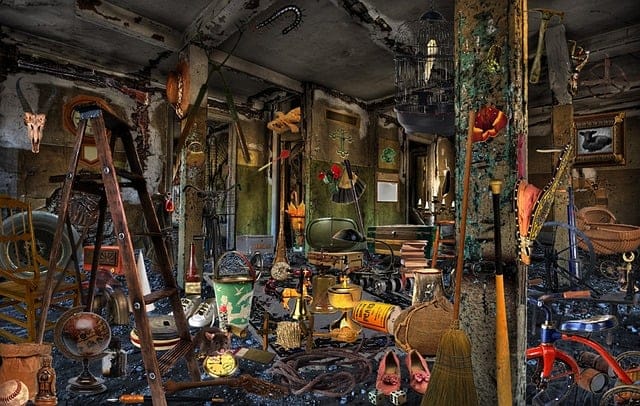Crammed homes stuffed with items that one will not use but cannot discard is a common scene around us. Even as minimalism gains momentum amongst people, the community of hoarders is no way diminishing. There are several TV Shows that showcase the bitter-sweet process of decluttering as professional organizers take on the task of counselling and convincing hoarders to ‘let go’.
While there are disadvantages and inconveniences to hoarding, there are advantages to keeping old things and using them well, in a world where sustainability is a virtue. Sometimes it’s great to keep old stuff even for the sake of nostalgia. How can one identify whether one is hoarding for ‘good’ or for ‘bad’? How can one uncover the thoughts and underlying complexes behind hoarding without deceiving ourselves? How can one identify that the hoarding habit is going too far? Maybe these thoughts may help…
The hoarding mind
Before we dismiss hoarding as a mere habit, it would probably be useful to take a glimpse into the mind of a hoarder. A hoarder experiences anxiety and distress when it comes to getting rid of possessions that they may not need. There may be severe thoughts running in their head when it comes to buying new things or discarding old things. What if I need this? This could be useful in the future. What if I don’t get this again? Someday I will use it. All these thoughts lead to anxiety.
A hoarder may also be impulsive. This trait is seen more when they buy or accumulate stuff. A recent research study that studied hoarding behavior during the pandemic suggested that hoarders have increased ‘neuroticism’. This includes tendency toward anxiety, depression, self-doubt, and other negative feelings.
Consequences
Untidy surroundings may just be the tip of the iceberg. Excessive hoarding could cause many more problems for the hoarder and their families. Firstly, there are health and safety risks, if hoarding has gone beyond acceptable limits, and one has stuff spilling all over the house. Risks include tripping over stuff, fire hazards, risk of injuries due to things falling over. Second, it impacts relationships by causing resentment and anger amongst family members and partners who may not be hoarders themselves. After all, tiffs between partners or parents and children over ‘untidy’ rooms and desks are too commonplace! Over-cluttered spaces cause stress and arguments, often straining family relationships.
Hoarding maintains impulsive behaviour. Research indicates that hoarders can be very impulsive.
Many of us have a tendency to hoard and clutter. We may at times experience a reluctance to let go of things. However, when this tendency becomes so severe that it starts to interfere with daily living, it may indicate a hoarding disorder, which is a chronic difficulty with letting go of possessions. There is a marked distress that hoarders experience if they have to let go of stuff. Moreover, the hoarding is so severe that it actually makes living spaces difficult to inhabit. For instance, there may be a bed in the room, but completely covered with stuff, such that one is unable to sleep on it!
In fact, the Diagnostic and Statistical Manual of Mental Disorders or the DSM-V published by the American Psychiatric Association, classifies hoarding disorder as a part of the Obsessive-Compulsive and Related Disorders.
Take this informal quiz just to see if you are on the hoarding side of the spectrum. Do note, that this is not a diagnostic quiz, just something that will give you some insight.
A self-help exercise
Here is a short activity that may help you understand your hoarding habits.
Analyze your unique hoarding style: Take a journal and do some honest introspection. Take feedback from family and friends who know you well. Consider three areas. Firstly, how do you tend to accumulate stuff? Do you buy more or refuse to discard? Second, how do you store stuff? Is it possible for you to easily retrieve what you need? Or does it get lost in the chaos? Thirdly, how do you discard stuff? Does it cause panic or resistance? Once you have identified these basic points, you will have deeper insight into your hoarding pattern and you will understand which area to target.
From the above activity you need to see where the problem lies- accumulating stuff, in its organization or in discarding. Sometimes it could be that all or two of these areas are interconnected. Example, you may end up buying what you already have just because you have not organized it well. this could become a pervasive habit.
Once you have insight on which of the areas you need to target, think about simple ways you can handle the concerns. Set goals and break them up into subgoals so you don’t get overwhelmed.
Some other tips Handle hoarding
- Binge-watch: For some visual motivation, it is best to watch decluttering and cleaning shows that have motivated many people to address their concerns related to organizing. Tidying Up With Marie Kondo (Netflix) is a popular show, though here are some other suggestions.
- Read to get organized! You may this curated list of books on decluttering a good starting point for some guidance.
- Take help of a professional organizer if you are overwhelmed with stuff at home.
- Get organized. It will help you manage and systemize incoming and outgoing ‘things’ and maintain a healthy balance.
- Practice relaxation techniques on a regular basis as it helps deal with anxiety and impulsiveness related to hoarding.
- Join a support group. Use social media to search for local support groups.
- If you feel that hoarding behavior is leaning towards a disorder, it is best to seek professional help from a psychologist. Techniques such as systematic desensitization and other cognitive behavioral approaches are effective interventions.
Maybe it is time to understand the nuances of hoarding. It is about understanding that while it is important to take things as they come, it is even more essential to leave them when they need to go!




